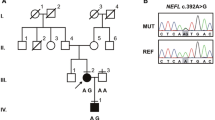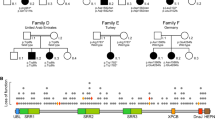Abstract
Mutations in GJA12 have been shown to cause Pelizaeus–Merzbacher-like disease (PMLD). We present two additional patients from one family carrying a homozygous frameshift mutation in GJA12. Both presented initially with nystagmus. The older girl developed ataxia first, then progressive spastic ataxia. The younger boy suffered from severe sensory neuropathy. Magnetic resonance imaging (MRI) of both children showed progressive demyelination in addition to dysmyelination, and also characteristic brainstem abnormalities. In children with nystagmus, ataxia and dysmyelination, mutation analysis of GJA12 should be considered early, especially if inheritance is autosomal recessive.



Similar content being viewed by others
References
Ellis D, Malcolm S (1994) Proteolipid protein gene dosage effect in Pelizaeus–Merzbacher disease. Nat Genet 6:333–334
Inoue K (2005) PLP1-related inherited dysmyelinating disorders: Pelizaeus–Merzbacher disease and spastic paraplegia type 2. Neurogenetics 6:1–16
Wolf NI, Sistermans EA, Cundall M, Hobson GM, Davis-Williams AP, Palmer R, Stubbs P, Davies S, Endziniene M, Wu Y, Chong WK, Malcolm S, Surtees R, Garbern JY, Woodward KJ (2005) Three or more copies of the proteolipid protein gene PLP1 cause severe Pelizaeus–Merzbacher disease. Brain 128:743–751
Van der Knaap MS, Valk J (1989) The reflection of histology in MR imaging of Pelizaeus–Merzbacher disease. Am J Neuroradiol 10:99–103
Uhlenberg B, Schuelke M, Rüschendorf F, Ruf N, Kaindl AM, Henneke M, Thiele H, Stoltenburg-Didinger G, Aksu F, Topaloglu H, Nurnberg P, Hübner C, Weschke B, Gärtner J (2004) Mutations in the gene encoding gap junction protein alpha 12 (connexin 46.6) cause Pelizaeus–Merzbacher-like disease. Am J Hum Genet 75:251–260
Woodward K, Kendall E, Vetrie D, Malcolm S (1998) Pelizaeus–Merzbacher disease: identification of Xq22 proteolipid-protein duplications and characterization of breakpoints by interphase FISH. Am J Hum Genet 63:207–217
Wolf NI, Willemsen MA, Engelke UF, van der Knaap MS, Pouwels PJ, Harting I, Zschocke J, Sistermans EA, Rating D, Wevers RA (2004) Severe hypomyelination associated with increased levels of N-acetylaspartylglutamate in CSF. Neurology 62:1503–1508
Bugiani MD, Al Shawan S, Lamantea E, Bizzi A, Bakhsh E, Moroni I, Balestrini MR, Uziel G, Zeviani M (2006) GJA12 mutations in children with recessive hypomyelinating leukoencephalopathy. Neurology 67:273–279
Plecko B, Stockler-Ipsiroglu S, Gruber S, Mlynarik V, Moser E, Simbrunner J, Ebner F, Bernert G, Harrer G, Gal A, Prayer D (2003) Degree of hypomyelination and magnetic resonance spectroscopy findings in patients with Pelizaeus Merzbacher phenotype. Neuropediatrics 34:127–136
Hobson GM, Huang Z, Sperle K, Stabley DL, Marks HG, Cambi F (2002) A PLP splicing abnormality is associated with an unusual presentation of PMD. Ann Neurol 52:477–488
Nezu A, Kimura S, Takeshita S, Osaka H, Kimura K, Inoue K (1998) An MRI and MRS study of Pelizaeus–Merzbacher disease. Pediatr Neurol 18:334–337
Odermatt B, Wellershaus K, Wallraff A, Seifert G, Degen J, Euwens C, Fuss B, Bussow H, Schilling K, Steinhauser C, Willecke K (2003) Connexin 47 (Cx47)-deficient mice with enhanced green fluorescent protein reporter gene reveal predominant oligodendrocytic expression of Cx47 and display vacuolized myelin in the CNS. J Neurosci 23:4549–4559
Author information
Authors and Affiliations
Corresponding author
Rights and permissions
About this article
Cite this article
Wolf, N.I., Cundall, M., Rutland, P. et al. Frameshift mutation in GJA12 leading to nystagmus, spastic ataxia and CNS dys-/demyelination. Neurogenetics 8, 39–44 (2007). https://doi.org/10.1007/s10048-006-0062-0
Received:
Accepted:
Published:
Issue Date:
DOI: https://doi.org/10.1007/s10048-006-0062-0




